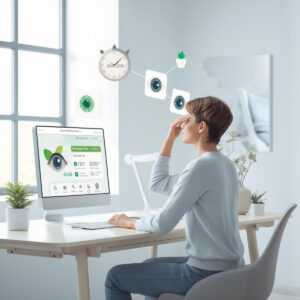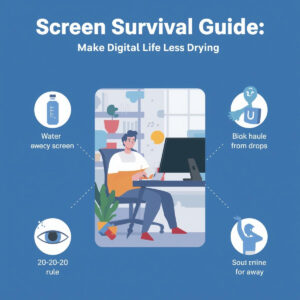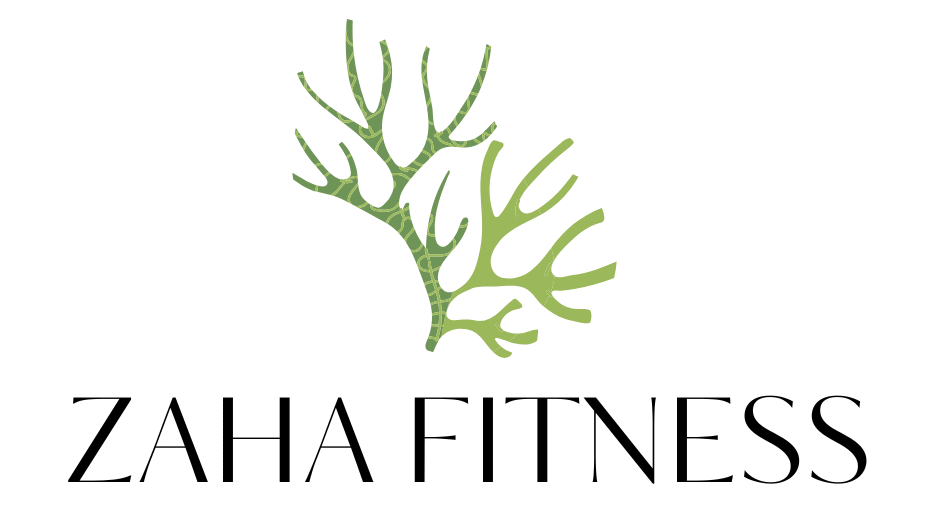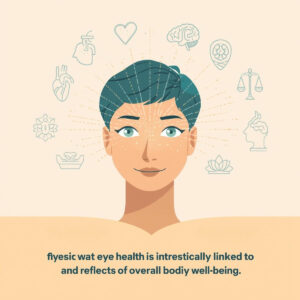If your phone brightness has become your personal sunrise and your laptop has seen more of you than your friends have, your eyes are probably filing a complaint. Health and fitness isn’t just about your steps, abs, or protein count—your eyes deserve a training plan too. Here’s a practical, slightly witty, 100% original guide to keeping your eyes healthy, comfy, and sharp.
Quick note: The tips below are general wellness advice. If you have pain, sudden vision changes, or any eye disease, see an eye-care professional promptly.

Why “Eye Fitness” matters
Think of your eyes like elite teammates. They don’t lift dumbbells, but they still need:
- Fuel: Nutrients that protect the retina, cornea, and tear film.
- Circulation: Cardio improves blood flow that nourishes ocular tissues.
- Ergonomics: Good screen and posture habits prevent strain.
- Recovery: Sleep and breaks repair the system.
- Protection: UV, dust, and impact safety to avoid injury.
Must Read: 10 Best Health Benefits of a Morning Walk
Nutrition:
a grocery list your eyes will thank you for
You can eat your way to happier eyes—no exotic powders required.
- Vitamin A: Eggs (especially yolks), dairy, carrots, and liver. Supports the cornea and low-light vision.
- Lutein and Zeaxanthin: Spinach, kale, mustard greens, broccoli, peas, corn, and egg yolks. These carotenoids concentrate in the macula and help filter harmful light.
- Omega-3s: Salmon, sardines, mackerel, flaxseed, chia, walnuts. Helpful for dry eye comfort and overall inflammation balance.
- Vitamin C and E: Citrus, berries, tomatoes, bell peppers, almonds, sunflower seeds. Antioxidants that defend delicate eye tissues.
- Zinc: Chickpeas, lentils, pumpkin seeds, beef. Helps your body utilize vitamin A effectively.
- Hydration: Dry eyes love water more than drama. Sip throughout the day rather than chugging all at once.
Must Read: 12 Proven Ways to Lose Belly Fat Quickly
Kitchen tweaks that help:
- Go easy on ultra-processed sweets: Blood sugar rollercoasters aren’t eye-friendly.
- Caffeine is fine in moderation, but too much can worsen dryness.
- Add anti-inflammatory spices—turmeric, ginger, garlic—to everyday meals.
Movement and blood flow: fitness for better vision support
- Cardio counts: Brisk walking, cycling, dancing, or swimming support healthy circulation, delivering oxygen and nutrients to the retina and optic nerve. Even 20–30 minutes most days helps.
- Lift smart: Breathing matters. Avoid holding your breath during heavy lifts—exhale on effort to reduce sudden pressure spikes. If you have glaucoma, retinal issues, or high myopia, ask your doctor which lifts and intensities are safest.
- Yoga with care: Deep inversions (like headstands) can raise eye pressure; people with glaucoma should favor gentler alternatives.
- Posture pays: Your head-forward phone pose can strain focusing muscles and neck. Keep screens at or slightly below eye level and sit back occasionally like a person who owns a chair.

Screen survival guide: make digital life less drying
Your eyes weren’t designed to stare at glowing rectangles all day, but here we are. Manage the glow; keep the eyesight.
Must Read: The 10 Best Vegan Meal Delivery Services in 2025
- 20-20-20 rule: Every 20 minutes, look 20 feet away for 20 seconds. Set a repeating reminder until it becomes automatic.
- Blink training: We blink less at screens. Every time you finish a paragraph or an email, close gently for three slow blinks. It’s like a tiny spa for your tear film.
- Distance and height: Keep monitors 50–70 cm (20–28 inches) away. The top of the screen should sit slightly below eye level to reduce strain.
- Brightness and contrast: Match screen brightness to room lighting; avoid working in a dark cave with a mini sun in front of you.
- Text size and zoom: If you squint, you’re losing. Bump text to 110–125% and increase line spacing if possible.
- Night modes and filters: Blue light filters at night can support sleep by reducing alerting light. Evidence for retinal protection is mixed, but they can reduce glare, which is a win.
- Glare control: Consider a matte screen protector and position lights so they don’t reflect on your display.
- Dryness hacks: A small desk humidifier helps. Preservative-free artificial tears can be useful a few times a day—check with your clinician if you have any underlying conditions.
Sleep: where eye recovery actually happens
- Aim for 7–9 hours. During sleep, your eyes rebalance the tear film and relax focusing muscles.
- Dim screens 1–2 hours before bed to support melatonin and morning clarity.
- Avoid air blasting directly at your face overnight; it dries the surface. If mornings feel gritty, try a warm compress for 5–7 minutes before bed and gently clean your lids.
Sun, dust, and the great outdoors
- Sunglasses: Choose 100% UVA/UVB (UV400) protection. Wraparound styles block side glare—great for midday sun.
- Hats help: A brim cuts direct light and squinting.
- Dusty or windy environments: Wear protective glasses; fashion can forgive you—your cornea won’t.
- Pools: Chlorine can aggravate dryness. Wear swim goggles. Avoid swimming in contact lenses—water plus lenses equals infection risk.
Must Read: Morning Walk vs. Evening Walk – Which Is Better?
Contact lenses, makeup, and hygiene
- Contact lens basics:
- Wash and dry hands before handling.
- Clean lenses with approved solution only—no tap water, no saliva.
- Rinse and air-dry the case daily; replace it every 3 months.
- Don’t sleep in lenses unless your doctor specifically okays extended wear.
- Makeup moves:
- Replace mascara every 3 months to avoid bacterial build-up.
- Remove all makeup before bed, especially along the lash line to keep oil glands unclogged.
- If lining the waterline irritates you, skip it or switch to gentler formulas.
Allergies and dry eye: calm the cranky
- Seasonal allergies: Wear sunglasses outdoors to block pollen, use cold compresses to reduce itch, and rinse your face and hair after returning home.
- Dry eye comfort:
- Warm compresses followed by gentle lid massage can help oil glands flow better.
- Hydrate, reduce direct air flow, and schedule screen breaks.
- Omega-3 sources in your diet may support tear quality.
- If redness, light sensitivity, or discharge shows up, get a professional exam before self-treating.
Whole-body health: your eyes read the body’s signals
- Blood pressure and blood sugar control are critical for retinal health. Keep up with routine checkups.

Zain Ul Hassan is the founder of Zaha Fitness. He writes practical, research-backed articles on fitness, weight loss, and natural health. His goal is to help people live healthier lives using simple and effective tips.

